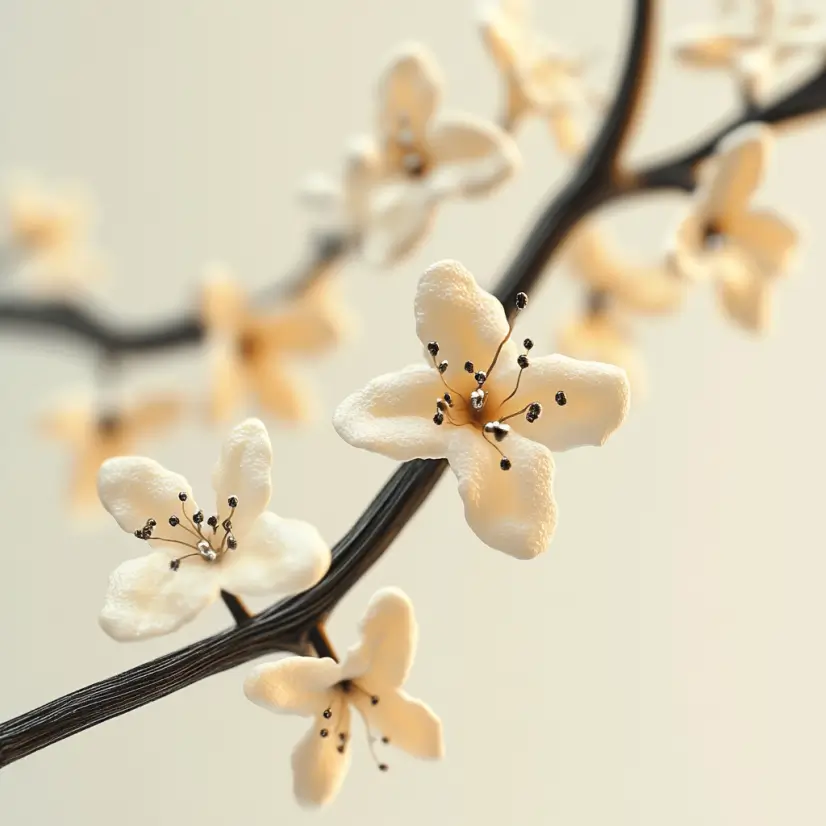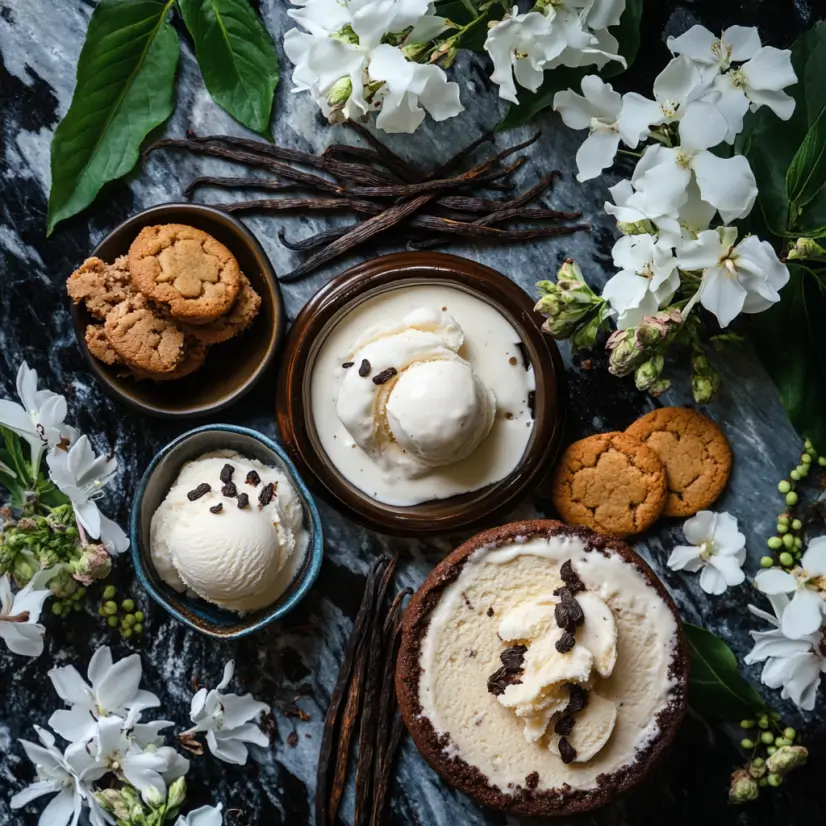Vanilla is a humble yet essential ingredient that elevates dishes from good to exceptional. From cakes to cookies and even savory dishes, its role goes far beyond adding flavor—it enhances, balances, and brings depth to recipes. In this article, we’ll delve into the fascinating chemistry behind vanilla, its role in baking, the types of vanilla you can use, and even how to make the most of it in diverse recipes. Let’s explore how vanilla affects a recipe and why it deserves a place in every kitchen.
Table of Contents
The Chemistry of Vanilla in Recipes

The Unique Compounds in Vanilla
Vanilla’s magic lies in its chemical complexity. It contains over 200 compounds, with vanillin being the star player. Vanillin is what gives vanilla its characteristic sweet, creamy aroma that tantalizes the senses. But vanilla isn’t just about sweetness—it adds a depth of flavor that complements other ingredients.
Interestingly, these compounds are released during cooking, blending seamlessly with fats, sugars, and liquids to create a harmonious flavor profile. This reaction explains why vanilla is often added to both sweet and savory dishes.
How Vanilla Interacts with Other Ingredients
Vanilla doesn’t work in isolation. It’s a team player in the culinary world! When combined with sugars, vanilla acts as a flavor amplifier, enhancing the sweetness and making it feel more pronounced. It also mingles with fats like butter, creating a rich and velvety texture in baked goods.
Moreover, vanilla balances bitterness. For instance, in chocolate-based recipes, it softens the sharpness of cocoa, making the end product smoother and more palatable. Without it, dishes can taste one-dimensional or flat.
Why Vanilla Is an Aromatic Enhancer
Another unsung quality of vanilla is its ability to bring out the natural aromas of other ingredients. Ever noticed how baked goods smell heavenly fresh out of the oven? That’s vanilla working behind the scenes, mingling with the heat and enhancing those aromatic compounds.
The Role of Vanilla in Baking
Why Vanilla Is Essential in Baking
Vanilla is more than just a flavor—it’s the soul of many baked goods. Its aromatic properties enhance the sweetness in recipes, creating a balanced, rich flavor profile. This is especially evident in cakes, cookies, and other confections where sweetness can sometimes feel overwhelming without a subtle balance.
When added to batter, vanilla binds other flavors together, creating harmony in every bite. Without it, baked goods may taste flat or lack depth. For instance, chocolate cakes rely on vanilla to mellow the bitter tones of cocoa, delivering a smoother and more enjoyable flavor.
Alternatives to Vanilla in Baking
Although pure vanilla extract is the go-to choice for many, substitutes can save the day when you’re out of this versatile ingredient. Almond or maple extract can bring a unique twist to your recipes, though they won’t replicate the exact warmth of vanilla. Another option is vanilla-flavored syrup, often used in beverages but effective in baked goods too.
Still, it’s important to adjust quantities when using substitutes, as some are stronger or sweeter than vanilla. Experimenting with these alternatives can open new doors to creativity in the kitchen.
Types of Vanilla and Their Impact
Pure Vanilla Extract vs. Artificial Vanilla
When considering how vanilla affects a recipe, the type of vanilla you use plays a crucial role. Pure vanilla extract, derived from real vanilla beans, offers a complex flavor unmatched by its synthetic counterpart. Its subtle sweetness and depth elevate recipes, making it ideal for gourmet dishes.
Artificial vanilla, while more affordable, lacks the same sophistication. It often has a one-dimensional sweetness that might not blend as seamlessly. However, for casual or budget-conscious bakers, it can still provide the necessary flavor boost.
Forms of Vanilla: Beans, Paste, and Powder
Vanilla is available in several forms, each tailored for specific purposes. For example, vanilla beans are prized for their aromatic seeds, making them ideal for custards and creams where presentation matters. Another option, vanilla paste, provides a concentrated flavor that works well in recipes needing a strong taste without changing the liquid balance.
Alternatively, vanilla powder serves as a dry option, especially useful in baked goods like cookies or muffins. By understanding these forms, you can choose the best one for your culinary creations.
For more inspiration on utilizing these different forms of vanilla, you might explore this guide on vanilla-based baking essentials.
Using Vanilla in Different Recipes

In Desserts: Cakes, Cookies, and Ice Cream
Vanilla is a must-have ingredient in most desserts, from fluffy cakes to creamy ice creams. It’s not just about adding flavor—it’s about creating a foundation of aroma and depth. For cakes, vanilla enhances the sweetness of sugar and the richness of butter, producing a well-rounded taste that feels comforting.
In cookies, vanilla works alongside other ingredients like chocolate chips or spices, acting as a flavor harmonizer. And let’s not forget its role in ice cream, where it shines as a standalone flavor or complements mix-ins like caramel or nuts.
For a detailed example of how vanilla impacts baked goods, you might enjoy exploring our guide on vanilla-infused bread recipes.
In Savory Dishes: Unexpected Uses
While vanilla is typically associated with sweet dishes, it can also elevate savory recipes. Vanilla pairs surprisingly well with meats like pork and chicken, where it enhances marinades and glazes. For instance, adding a touch of vanilla to a balsamic reduction can add complexity to roasted vegetables or grilled meats.
Another intriguing use is in soups and sauces, where vanilla provides a subtle sweetness that balances acidity or spiciness. This versatility makes it a secret weapon for adventurous cooks looking to explore how vanilla affects a recipe in unexpected ways.
FAQs: Vanilla in Cooking and Baking
Does Vanilla Make a Difference in Recipes?
Yes, vanilla makes a significant difference by enhancing other flavors and adding complexity. Without it, many recipes may lack depth and richness. Vanilla’s subtle aroma elevates the overall sensory experience, turning an average dish into something memorable.
What Happens if You Skip Vanilla in a Recipe?
Skipping vanilla can result in a recipe tasting flat or incomplete. While it’s not always the primary flavor, vanilla plays a supporting role that binds ingredients together. If you’re out of vanilla, substitutes like almond or maple extract can work in a pinch, though the flavor profile will differ.
How Much Vanilla Should You Use?
The amount of vanilla depends on the recipe. A teaspoon of pure vanilla extract is standard for most baked goods. However, for recipes like custards or ice creams where vanilla is the main flavor, you might need more. Adjust according to taste and the form of vanilla you’re using.
For more helpful tips on flavoring recipes, explore our article on the impact of adding vanilla to bread.
Vanilla’s Cultural and Historical Significance
The Origins of Vanilla
Vanilla has a rich history that dates back to ancient civilizations. Native to Central America, vanilla was first cultivated by the Totonac people in Mexico. Later, the Aztecs embraced it, using vanilla to enhance the flavor of their cacao-based beverages. This early use hints at how vanilla affects a recipe by adding depth and complexity.
European explorers introduced vanilla to the rest of the world, where it became a sought-after luxury. Today, Madagascar is the largest producer, with its beans known for their creamy and floral notes.
Vanilla’s Place in Modern Kitchens
Fast forward to modern times, and vanilla remains a staple in kitchens worldwide. Its versatility extends beyond traditional recipes—it’s now used in beverages, skincare products, and even perfumes. However, its culinary applications remain the most celebrated.
From home bakers experimenting with new flavors to professional chefs crafting gourmet dishes, vanilla continues to play a key role. Its ability to elevate both sweet and savory creations showcases its timeless appeal.
Sustainability and Ethical Considerations of Vanilla Production
The Challenges of Vanilla Cultivation
Vanilla cultivation is labor-intensive, requiring manual pollination and careful processing. Farmers in regions like Madagascar, Indonesia, and Mexico work tirelessly to produce the high-quality beans we enjoy. However, challenges like fluctuating prices, climate change, and theft make vanilla farming precarious.
Understanding the effort behind this ingredient adds an appreciation for how vanilla affects a recipe. Every teaspoon of vanilla carries the story of the hard work and dedication of those who cultivate it.
Choosing Ethically Sourced Vanilla
To support sustainable vanilla production, many consumers opt for ethically sourced products. Certifications like Fair Trade ensure that farmers receive fair compensation and work under humane conditions. These efforts not only help farmers but also ensure the long-term availability of vanilla.
When shopping, look for pure vanilla extract labeled as sustainably sourced. It’s a small step that can make a big impact on the environment and the livelihoods of farmers.
Common Mistakes When Using Vanilla
Using Too Much or Too Little Vanilla
Vanilla is a gentle ingredient, and finding the right amount is key. Using too much can overpower a recipe, while using too little can make it taste plain. For example, adding too much vanilla to a pudding might hide other flavors, while leaving it out in a cake can make it taste dull.
To get the best results, follow the recipe or adjust based on the type of vanilla you’re using. Vanilla extract is strong, but vanilla paste might need a bit more to get the same flavor. These details show how vanilla affects a recipe by making other ingredients work well together.
Choosing Artificial Vanilla Over Real Vanilla
Another common error is replacing real vanilla with artificial vanilla without knowing the difference. While fake vanilla can add sweetness, it doesn’t have the same rich flavor as the real thing. It works in some recipes but might not taste good in ones where vanilla is the main flavor.
If you have to use artificial vanilla, add it in recipes where other strong flavors, like chocolate or cinnamon, take the lead. This way, the artificial taste won’t stand out as much.
Tips to Get the Most from Vanilla
Storing Vanilla the Right Way
Storing vanilla correctly helps keep its taste and smell strong. Keep vanilla beans, extract, or paste in a cool, dark spot, away from sunlight. Use tight containers for beans so they don’t dry out. These steps make sure your vanilla stays fresh, so you can enjoy how vanilla affects a recipe.
Don’t put vanilla beans in the fridge, as it can cause mold. Instead, store them in a tight container at room temperature with a little alcohol or sugar to keep them fresh longer.
Adding Vanilla in Layers for Better Flavor
To get a stronger taste, try using different forms of vanilla in one recipe. For example, use vanilla extract in the batter and vanilla paste or beans in the icing. This adds layers of flavor and makes sure vanilla is tasted in every bite.
Trying out layering can also help you see how flexible vanilla is, so you can create dishes that smell and taste amazing.

